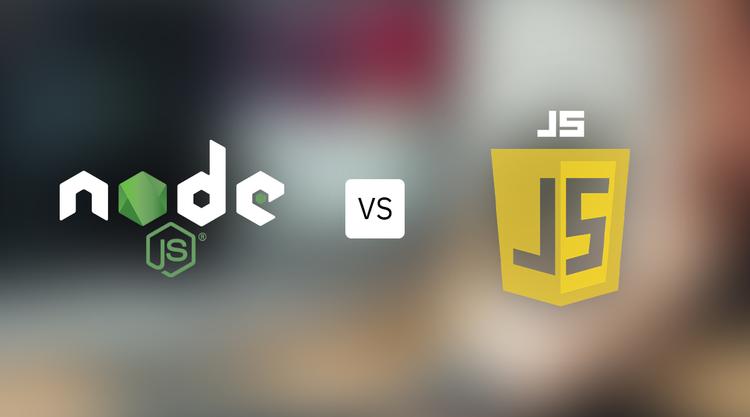Node.js vs. JavaScript: What Is Better?
Sector: Technology
Author: Nisarg Mehta
Date Published: 06/17/2022

Contents
- What is Node.js?
- The Benefits of Node.js
- Challenges with Node.js
- How the Future Looks for Node.js
- Examples of How Leading Companies Use Node.js to Drive their Success
- What is JavaScript?
- The Benefits of JavaScript
- Challenges with JavaScript
- How the Future Looks for JavaScript
- Examples of How Leading Companies Use JavaScript to Drive their Success
- Comparison Table: Node.js vs JavaScript
- Conclusion
JavaScript is an object-oriented, lightweight scripting language leveraged to create dynamic HTML pages with engaging effects. On the other hand, Node.js typically signifies a list of objects and methods available to JavaScript programming, which operates in the V8 engine or through the node interpreter.
In this blog, we will discuss the variance between Node.js and JavaScript development. However, before discussing the differences, we will explore Node.js and JavaScript.
What is Node.js?
Well, the plainest definition of Node.js is that it is a JavaScript runtime environment that assists in implementing JavaScript programming on the server-side. It is a precise open-source and cross-platform JavaScript that aids real-time network app development.
Node.js comes with several modules and is mainly utilized in web-based development. It enables event-driven and non-blocking (asynchronous) I/O for building scalable server-side JavaScript apps. It can operate on multiple platforms comprising Windows, Mac OS, and Linux.
Node.js can be utilized to craft various applications like real-time chat apps, command-line applications, and facilitating REST API servers.
The Benefits of Node.js
Let us explore the significant benefits of leveraging Node.js as server-side programming:
Simple to Learn
JavaScript is a prevalent programming language, and most front-end developers have a proper grip over it.
It becomes much simpler for them to leverage the Node.js at the backend. It is easy to learn Node.js and takes less time to work with it professionally.
Keep Stuff Easier
Node.js offers simple sharing of one language both on the client and server sides, and there is no need to switch between front-end and backend.
Both the code and deployment are in one single place. So, the apps crafted in Node.js need fewer files and minimal code when matched to those with diverse languages for both ends. You can even reuse and share the code, which boosts the swiftness of the development procedure.
This substantial assistance is particularly valued early in your product development. You can have a full-stack development team for both sides and minimize costs on resources or hourly.
Quicker Time to Market
Time is invaluable for both startups and enterprise companies. Startups especially have to work persistently to iterate quickly, enable testing and deployment and deliver as swiftly as possible, with lesser budgets.
Node.js is predominantly accommodating in making the time-to-market cycle quicker. With Node, you can get from the project concept to complete the product in a rapid time. Also, easy deployments assist you in getting instant feedback right from the production environment.
This scenario is possible as the technology is relatively lightweight and can immensely trim down the app development time while attaining the same features and functionalities.
Scalable Solutions
Scalability is one of Node’s advantages for companies planning to mature over time. Organizations select it to build lightweight and swift solutions with a better real-time response that can be further scaled up and enable the addition of modules to the present ones
Node’s scalability is accomplished by the load balancing and the competence to manage immense concurrent connections. Besides, Node’s applications back both horizontal and vertical project scaling.
Node.js is explicit for microservices architecture, which is advantageous for developing projects that will scale and cultivate in the coming time. Also, it is probable to build a distinct microservice for any features and functionality and then scale it discreetly.
MVP Development
Shorter timelines and restricted project budgets mean it is worth swiftly verifying the marketability of the product’s concept with lesser efforts, resources, and upfront investments. This scenario ensures the product is viable before putting time and funds into full-fledged development.
Node.js allows rapidly building an MVP (Minimum Viable Product), a software solution with merely good features so that the product can go to the marketplace and please the primary customer base. MVP is an elementary stage in the approach to a full-fledged app development project.
Active Community
Node.js has a large-sized and highly active community of programmers who keep on endlessly contributing to its added development and enhancement.
The groups of programmers are backed by JavaScript developers offering more straightforward solutions and codes. It is expected that today’s programmers will initiate and support many other programmers in the coming time.
High-Performance
Node.js infers the JavaScript code through Google’s V8 JavaScript engine. The engine conforms the JavaScript code straight into the actual machine code. This scenario makes it effortless and swifter to execute the code efficiently.
An explicit runtime environment even improves the swiftness of the code execution as it backs the non-blocking I/O operations.
Highly Extensible
Node.js is superiorly extensible, and you can easily customize and extend Node.js as per need. It is also enabled with in-built APIs for building HTTP, TCP, and DNS servers. You can even use JSON to offer the scope for exchanging information between the web server and the clientele.
Back Real-time Applications
You can now operate constant web-based applications with Node.JS at a higher speed and the time needed for loading a static web page in other programming languages. This scenario is one of the prime benefits of selecting Node.js over other development languages.
Full Stack JavaScript
Node.js is a full-stack JavaScript as it effortlessly serves both the client and the server-side applications.
Hence, the benefit is that you don’t have to hire distinct programmers for backend and front-end development. It saves your valued funds, efforts, and time.
Challenges with Node.js
Issues occurring in Node.js application development can have a series of symptoms, and we have categorized some into the following:
API is Not Stable
One of the most crucial challenges with the Node.js user base is the recurrent API deviations, primarily backward-incompatible, that steer them up the wall. Regrettably, this forces them to repeatedly alter the access code to match in sync with the newest version of Node.js API.
Lacks Sturdy Library Support System
Many NPM registries and libraries are either deprived of quality or not fittingly documented. Hence this insufficient tracking is challenging if some beginner builds a web-based application in Node.js.
So, most of the time, only the professionals with project experience can steer success to your project. On the contrary, it is open-source, and these poor levels of libraries might generate a lack of high coding benchmarks.
Hence, choosing the precise technology partner to craft your web applications is significant for an innovative set of results.
Asynchronous Programming Model
For building scalable applications, the essential requisite is acceptance of the asynchronous programming model. However, many programmers find this model more problematic when matched to the linear blocking I/O programming.
Another disadvantage of the model is the codes depend a lot on nested calls because of the principal nature of an asynchronous function and approach. This function runs merely after each task in the queue, safekeeping multiple queued activities in the background still operating.
The callback impacts the performance levels and the quality of the code. This restraint makes it monotonous to comprehend and sustain the code.
Reduces Performance when Managing Heavy Computing Tasks
Node.js falls short at performing and managing heavy CPU-based computing. When Node.js gets a sizable CPU-controlled activity in its event loop, it uses all of its accessible CPU strength to realize the task. This scenario slows the event loop and delays your app’s interface.
To resolve this challenge, Node.js launched the “worker threads” module, enabling programmers to execute numerous threads concurrently. However, this solution does not entirely prepare you to handle CPU-bound computation encounters.
High demand with a Limited Proficient Node.js Developers
Students jump into the talent pool each year and enroll in the curving requirements of the industry to remain ahead in this viable marketplace. Even the technology giants aggressively compete to clutch the unique talents yearly at career events.
Regrettably, the demand is rising exponentially quicker than anticipated, and there aren’t many proficient node.js programmers to match marketplace requirements.
How the Future Looks for Node.js
Node JS in 2022 looks like a big trend that will advance even more. It provides some indisputable advantages that make it the essential choice for developers.
The coming time appears outstanding for Node JS technology in the front-end space as it looks like no front-end upgrading is possible without Node.js, at least in the current period.
Node.js motivates clients to do everything from crafting microservices to enabling multipurpose applications’ conveyance. It also assists in synchronizing non-web frameworks to take advantage of serverless structures.
Node.js is also offering an establishment of the Internet of Things (IoT) as a fundamental stage. Experts state that the customers can expect to view a more substantial mixture of provisions in IoT just as diverse sorts of instrumentation.
Examples of How Leading Companies Use Node.js to Drive their Success
Node.js resolves multiple production issues for leading companies. Some are platform-oriented, while others concentrate on resource utilization.
Top organizations like PayPal, Netflix, and LinkedIn all have acknowledged loading-time savings of up to 60%, as stated by Hackernoon.

1. Netflix
With a 182+ million subscriber base, Netflix has been attempting to enhance its interface loading swiftness for improved user experience. Until 2015, it was leveraging a Java-based backend, which was helpful for data handling but provided poor user-wait times.
As the JavaScript front-end didn’t connect resourcefully with the Java-based backend, Netflix moved to Node.js to utilize the performance gains of node.js.
Why Netflix switched to node.js
- Monolithic app design made it tough to scale with the increasing user base.
- The conversion from the backend to the front-end was not seamless, leading to high load time and causing dormancy at user levels.
- UI personalization according to user requirements was challenging due to synchronous loading.
- JAVA’s bulky build time trimmed development and deployment swiftness.
2. NASA
NASA faced challenges in merging its discrete legacy databases interrelated to EVA Spacesuits. It made it problematic for scientists to access databases for research projects. Data access was sluggish and needed digging through numerous locations to get the correct data for thorough research.
The Node.js enterprise architecture for NASA required an API-oriented architecture, so they better switch to Node.js.
Why NASA switched to node.js
- Data logged by Spacesuits were spread across diverse locations.
- NASA’s data is siloed in wrapped databases that are tough to query and sort.
- The organization was running on-premise data centers, which weren’t cloud-enabled.
- Many of NASA’s current applications were JavaScript reliant.
3. Trello
The Trello team was exploring a lightweight server with enhanced loading speeds. Trello was developed on Coffeescript, a language that assembles JavaScript, so the team prioritized JavaScript nativity.
Trello required an event-driven technology that could process numerous synchronized requests at once. Hence, Node.js became the top selection for precisely those reasons.
Why Trello switched to node.js
- The app required quick updates with the least latency.
- Trello’s architecture is based on JavaScript. A server with a comparable methodology was needed to make the code sustainable and quicker to develop.
- Trello needed real-time open connections on the server to sustain the swiftness and delivery of upgrades.
4. PayPal
PayPal, leveraged by 87.5 percent of digital buyers to make online payments, was facing JAVA to JavaScript conversion issues, leading to condensed loading time and payment processing challenges.
The developers were highly skilled at JAVA, but many differences arose in the development procedure due to the JavaScript front-end. PayPal migrated from Java to Node.js, turning one of the foremost organizations to do the same.
Why PayPal switched to node.js
- Various development procedures for JAVA programming did not easily sync front-end development.
- The development time for the JAVA apps was comparatively higher with sluggish performance levels.
- JAVA’s high environmental dependences lead to low productivity levels at PayPal.
5. LinkedIn
LinkedIn, with a 690+ million user base, is one of the prime applications that use Node.js components in production.
LinkedIn earlier worked with Ruby on Rails and then moved to Node.js. By enabling Node.js as their backend platform, they switched from synchronous to asynchronous request procedures, which provides quicker interface loading swiftness. Implementation of Node.js boosted app performance and considerably reduced resource usage.
Why LinkedIn switched to node.js
- The server took an extra load when there was an upsurge in online traffic.
- LinkedIn couldn’t handle numerous concurrent requests with Ruby on Rails.
- The Ruby application is executed synchronously, turning the pages heavyweight while loading.
What is JavaScript?
JavaScript is a renowned programming language that enables the implementation of multifaceted functionalities on web pages. JavaScript is always involved when a web page showcases static data and timely content updates. It is also applied while leveraging engaging maps, animated 2D/3D graphics, and scrolling video jukeboxes. It is the 3rd layer of the cake of benchmarked web technologies, including HTML and CSS.
The Benefits of JavaScript
Let us discover the vital benefits of leveraging JavaScript for your development projects:
Valuable Client-Side Worker
JavaScript is a highly valued client-side worker, and you can make alterations from the client-side with the aid of this development language.
JavaScript allows you to add adequate engagement levels between the user base and web pages. With JavaScript, you get enhanced loading, clickable items, and improved interaction on web pages.
Entirely Independent
You may have perceived that working with other development languages requires installing many programs. However, you would never need any program with JavaScript before working with it.
Besides, JavaScript is backed by almost every web-based browser. So, you can better check your code straight via the web browser.
Exclusive Features
JavaScript comes with brilliant features and useful functionalities. The language offers many high-end features, and you can craft innovative projects with their assistance.
Create Multi-functional Websites
JavaScript assists in creating efficient multi-functional website portals. JavaScript provides more convenience while building multi-functional sites that you would not be able to get in any other programming language.
Backs Multiple Tasks Running
JavaScript provides you an event loop module functionality through which you can benefit from running multiple tasks at a similar time. Many professionals think that it will make their system slow. However, when a single code works, the complete effort would be put into that code individually, which is reversed with JavaScript.
Offers Interoperability
JavaScript works seamlessly with other development languages, and so it is preferred in building many applications. We can insert it into any web page or inside the script of different development languages.
Superior Interfaces
JavaScript offers multiple interfaces to programmers for crafting catchy web pages. Drag and drop elements may provide a superior interface to the web pages. This scenario leads to enhanced user base interactivity on the web pages.
Fewer Overheads
JavaScript enhances the performance levels of web applications by trimming down the code length. The codes comprise lesser overheads with the utilization of multiple in-built functionalities for precise loops and DOM access.
Challenges with JavaScript
Problems with JavaScript can have a succession of indications, and we have characterized some into the following:
Compromises Data Security
Since the JavaScript code is displayed to even the standard user, others may leverage it for malicious objectives. This scenario applies to utilizing the source code without secure authentication.
Correspondingly, it is elementary to place some code into the website that negotiates the data security levels over the site.
Lacks Browser Support
The browser reads JavaScript inversely. Thus, you must operate the code on multiple platforms before publishing. If the old browsers don’t back some new functionalities, you must always invest extra time to check them.
Devoid of Debugging Capabilities
Though some HTML editors back debugging, it is not as resourceful as other editors and prefer C/C++ editors. Likewise, as the browser doesn’t showcase any fault, it is tough for the programmer to find the issue.
It does not Support Multiple Inheritance
JavaScript merely backs single inheritance, and programs may need specific object-oriented language features.
Stopped Rendering
A single code error can halt the rendering of the complete JavaScript code on the site. To the user base, it appears as if JavaScript was not existing. Nevertheless, the browsers are enormously easy-going with these errors.
Slow Bitwise Function
JavaScript provisions a particular number as a 64-bit floating-point number, and operators run right on 32-bit bitwise operands. Hence, JavaScript changes the number to 32-bits signed integers, runs on them, and alters them back to 64-bits JavaScript numbers.
This constant change takes more time to modify the number to an integer. This scenario upsurges the time required to operate the script and trims down the speed.
How the Future Looks for JavaScript
As per GitHub,2.3 million developers leverage JavaScript, the most utilized development language on GitHub.
Unquestionably, numerous frameworks have their own recognized markets, which are continually mounting. However, one firm thing is the presence of one or the other JavaScript frameworks will stay in customized development services.
There is no possibility that JavaScript will drop its position as the most utilized programming language. The facts speak about its optimistic future!
Examples of How Leading Companies Use JavaScript to Drive their Success

1. Microsoft
Microsoft depends on JavaScript and is working effectively with JavaScript to craft its Edge web browser. All browsers require to process and perform JavaScript proficiently, so Microsoft sustains its JavaScript engine for Edge.
2. Groupon
Groupon leverages JavaScript for its web portal, splitting it into numerous web applications for more competent management. This marketplace crafts its mobile apps and front-end handling by using JavaScript.
3. Uber
Uber requires to manage heavy data on a real-time basis. They have numerous requests coming in endlessly, and that does not merely hit on a page. Uber leverages JavaScript for front-end and backend handling on its website. It manages considerable amounts of incoming data competently by using JavaScript.
4. Facebook
When you disable JavaScript in the web browser and try to operate Facebook, the site will essentially halt you from logging in as it won’t work without JavaScript.
You may have perceived the approach that Facebook loads. Each portion of the page is discrete. Facebook has enabled its techniques to break down and provide JavaScript sections discreetly. So, every compartment of your Facebook page is an assembly of autonomous JavaScript apps.
5. eBay
eBay leverages JavaScript for multiple front-end and backend development objectives. eBay’s technology stack banked on Java for some time, but Java wasn’t the precise solution for the organization. So, they migrated most of their user display stack to JavaScript and added Node.js to the tech stack.
Comparison Table: Node.js vs JavaScript
Key Difference | NodeJs | JavaScript |
Definition | It is a precise cross-platform and open-source JavaScript runtime environment that enables JavaScript to be operated on the server. | It is an explicit open-source, lightweight, and cross-platform development language that is leveraged to build web apps. |
Latest Version | js v18 | ES2015 |
Type of Development | Node.js can be leveraged to develop both web apps and native applications. | JavaScript is used to develop games, animated 2D & 3D graphics, and inclusive database-driven apps. |
Utility | It is leveraged for accessing non-blocking operations such as creating a shell script or accessing any hardware-specific data, or operating backend jobs. | It is leveraged for client-side activities for web apps, such as attribute validation or refreshing the page in a set interval, or offering dynamic alterations in web pages without page refreshing. |
Running Engine | Node JS is merely backed by the V8 engine, which Google Chrome applies. JavaScript programs written with Node JS will always operate in the V8 engine. | JavaScript can be operated on any engine, comprising Spider Monkey, V8, and JavaScript Core. |
Dedicated Server | It is commonly utilized on the server-side. | It is commonly utilized on the client-side server. |
Used for | It is better used for data-intensive real-time apps that operate on multiple platforms. | It is better used to develop network-centric apps. |
Languages | It leverages C, C++ & JavaScript. | It operates on Chrome’s V8 engine, which is coded in C++ language. |
Modules | Lodash and express are instances of Nodejs modules. These modules are imported right from npm. | JavaScript frameworks include TypedJS and RamdaJS. |
Companies Uses | Popular companies using Node JS include Netflix, NASA, Walmart, PayPal, LinkedIn, Medium, and Trello. | Popular companies using JavaScript include Google, Microsoft, Shopify, Udacity, Uber, SendGrid, Groupon, Facebook, Okta, eBay, and Instacart. |
Community | All Node JS projects characterize and represent the JavaScript community. | All the JavaScript projects are not significant to the Node JS community. |
Limitations | Node.js has to deal with a lot of code alterations because of unstable API. | JavaScript lacks multithreading and multiprocessor abilities. |
Purpose | Its key purpose is to enable conventional websites and backend API services. It comes with real-time and push-based architecture. | Its key purpose is to develop complex interactive sites and games and to link servers to web applications. |
Flow Control | Flow control in Node.js enables individual statements and instructions of an imperative program that is executed. | Flow control in JavaScript is how your computer operates and runs code right from top to bottom. |
Frameworks | Node.js frameworks include MVC, Full-Stack MVC, and REST API frameworks. | JavaScript frameworks include Angular, React, Vue. JS, Ember. JS, Meteor, Mithril, Node. JS, Polymer, Aurelia, and Backbone.js. |
Runtime Environment | Node. js is a cross-platform JavaScript runtime environment for apps and servers. | The JavaScript runtime environment offers access to in-built libraries that are accessible to a program so that it can engage with the exterior space and make the code workable. |
Productivity and Resource Consumption | Node.js productivity and resource consumption can be boosted by front-end tooling, use of SSL/TLS and HTTP/2, caching, and optimizing data handling techniques. | External libraries enhance productivity and resource consumption. The JavaScript Ecosystem is massive, and we can utilize it to save time and effort. |
Conclusion
JavaScript is an extremely popular programming language that can be easily leveraged by any web app developer. It is straightforward to find a resource for working on JavaScript and do some precise development projects.
Node JS is an extension of JavaScript libraries. However, it comes with explicit utilities like non-blocking operating system activities, which are highly needed for meeting unique project requirements.
Techtic has successfully worked on projects involving both JavaScript and Node JS. We can provide you with a dedicated Node.js development team who is an expert in developing dynamic web applications that are highly scalable and steady.
Let us get in touch to discuss your succeeding development projects and together realize technology accomplishments.
Latest Tech Insights!
Join our newsletter for the latest updates, tips, and trends.







